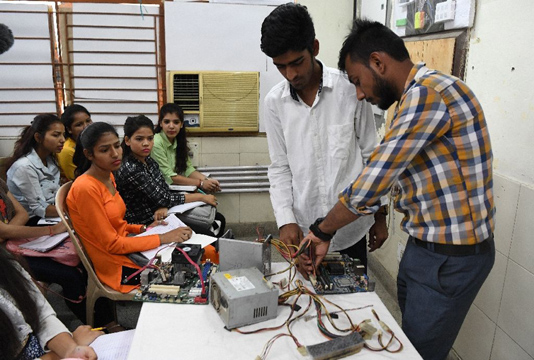NEW DELHI, May 26, 2019 (BSS/AFP) – Asad Ahmed, one of about 1.2 million
young Indians entering the cutthroat job market each month, diligently
scribbles notes at a computer class in New Delhi.
While nationalist Prime Minister Narendra Modi won a new five-year term
promising to step up his campaign for a “new India”, 18-year-old Ahmed is
pessimistic about getting a new job.
“There are so many people in Delhi and the competition is intense,” said
Ahmed, dressed like the other students in a black-and-white uniform at the
three-month community course run in a police station in Old Delhi.
“I know this stint may not be enough for me to get a job but I am trying
my best.”
Modi came to power in 2014 promising jobs, but delivering on that has been
a challenge.
And as soon as the election euphoria settles, Modi’s government will have
to find ways to boost investment and revive manufacturing to create new jobs.
Like Ahmed, most of the other 60 students at the government-sponsored
“skill development” classes at the Old Delhi police station, all from poor
families, were also apprehensive.
Nudrat Akram, 19, signed up for the course because her family could not
afford to pay for higher education.
“I want a job in the retail sector where I can earn 10,000 rupees ($143) a
month,” Akram said, as she practised speaking English with pretend customers.
– More jobs, more debt –
India’s conservative prime minister came to power in 2014 on a pro-
business platform, promising to create 10 million jobs a year.
The world’s fastest-growing major economy has grown about 7 percent a year
since, but jobs have been elusive.
The promise was barely mentioned in Modi’s triumphant re-election
campaign.
Nearly two-thirds of India’s 1.3 billion population are of working age,
between 15 and 64, but an increasing number are in the unemployed list.
No official data has been released for more than two years but a recent
leaked report — denied by the government — put the unemployment rate at a
45-year high of 6.1 percent.
The Centre for Monitoring Indian Economy, a private research firm,
estimates the jobless rate rose to 7.6 percent in April.
“The economy is going to be a huge problem. The government simply cannot
create jobs for millions entering the workforce,” said political analyst
Parsa Venkateshwar Rao.
“Modi will rely on businesses but they are also struggling so he has a
real problem on his hands.”
– ‘Not easy to survive’ –
Unemployment is particularly dire for women.
A Deloitte consultancy report in March said female labour force
participation fell to 26 percent in 2018 from 36 percent in 2005 because of
poor education and socio-economic barriers.
The manifesto of Modi’s Bharatiya Janata Party (BJP) promised a $1.4-
trillion infrastructure boost to create jobs if it won the election. It
offered metro trains for 50 cities and to double the national highway
network.
But analysts say the government, which has drastically increased its debt
over the past five years, will have to borrow huge new amounts to pay for the
works.
In 2015, Modi launched a Skill India programme aiming to train 500 million
people by 2022. But the results have been mixed.
According to 2018 data, only a quarter of people who joined the scheme
found jobs.
“The Skill India mission has not had as much success as say the highway
programme,” said economist Arvind Virmani.
“The real crisis is about job skills and basic education.”
India’s rural jobs guarantee programme offers work to about 70 million
people at a minimum wage for 100 days a year, but there is no equivalent for
the growing numbers of urban youth.
Experts say the government must consider an urban employment guarantee
scheme in order to reap the true benefit of its economic growth.
At the Delhi classes, 18-year-old Sehar, who uses one name, is worried
about helping her poor family, including four younger sisters.
Her father, who works at a hospital, is the only earner.
“I am the eldest and I want to help my family, it’s not easy to survive in
this city.”



